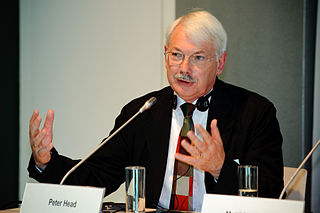Related Research Articles

The City and Guilds of London Institute is an educational organisation in the United Kingdom. Founded on 11 November 1878 by the City of London and 16 livery companies to develop a national system of technical education,the institute has been operating under royal charter,granted by Queen Victoria,since 1900. The Prince of Wales,later King Edward VII,was appointed the first president of the institute.
Sir Alec Westley Skempton was an English civil engineer internationally recognised,along with Karl Terzaghi,as one of the founding fathers of the engineering discipline of soil mechanics. He established the soil mechanics course at Imperial College London,where the Civil and Environmental Engineering Department's building was renamed after him in 2004,and was knighted in the 2000 New Year Honours for services to engineering. He was also a notable contributor on the history of British civil engineering.

Dr. Mao Yisheng a.k.a. Thomson Eason Mao (Chinese:茅以升;pinyin:Máo Yǐshēng;Wade–Giles:Mao2 I3-sheng1;January 9,1896 –November 12,1989) was a Chinese structural engineer and social activist. He was one of the most famous Chinese structural engineers,a pioneer in bridge construction,and a social activist.
Olgierd Cecil Zienkiewicz was a British academic of Polish descent,mathematician,and civil engineer. He was born in Caterham,England. He was one of the early pioneers of the finite element method. Since his first paper in 1947 dealing with numerical approximation to the stress analysis of dams,he published nearly 600 papers and wrote or edited more than 25 books.
Willis Jackson,Baron Jackson of Burnley FRS was a British technologist and electrical engineer.

Arthur Clifford Hartley,CBE was a British civil engineer. Graduating with a bachelor's degree from Imperial College London,Hartley worked for the North Eastern Railway and an asphalt manufacturer before joining the Royal Flying Corps during World War I. He became a qualified pilot,with the rank of major and joined the Air Board where he was involved with the development of interrupter gear. His war work was rewarded with his appointment as an Officer of the Order of the British Empire (OBE). He left the corps after the war and spent five years as a consulting engineer before he joined the Anglo-Persian Oil Company.
The City and Guilds College Union represents students who are undertaking courses from the departments of Aeronautical,Chemical,Civil,Design,Electrical,and Mechanical Engineering,together with Bioengineering and Computing at the college. Other students within the faculty are represented by the Royal School of Mines Students' Union. These follow the names of two of the three former 'Constituent Colleges' that formed Imperial in the early 20th century. The City and Guilds Union's name derives from the original City and Guilds College from which the faculty was formed. The union hosts an annual welcome dinner,and members of the union are traditionally known as Guildsmen and Guildswomen. The students' union brings together the 8 departmental societies,and organises events throughout the year,and to welcome new students.
Jai Krishna was an eminent civil engineer from India with specialisation in earthquake engineering. He served University of Roorkee for many years and rose to become its Vice Chancellor.

The Faculty of Engineering is one of four faculties of Imperial College London,in London,England. Imperial's Faculty of Engineering was formed in 2001,from two of the universities constituent colleges - the Royal School of Mines and City and Guilds College. The faculty is ranked as the top engineering institute in the UK in the 2021 Research Excellence Framework.

The Department of Civil and Environmental Engineering is the academic department at Imperial College London dedicated to civil engineering. It is located at the South Kensington Campus in London,along Imperial College Road. The department is currently a part of the college's Faculty of Engineering,which was formed in 2001 when Imperial College restructured. The department has consistently ranked within the top five on the QS World University Rankings in recent years.
William Ernest Dalby,FRS was a British engineer.
Cheng Hon-kwan is a Hong Kong engineer and politician. He was the member of the Executive Council and Legislative Council of Hong Kong in the 1980s and was chairman of the Hong Kong Housing Authority from 2000 to 2002.
Roy Thomas Severn was a British civil engineer and earthquake engineering expert. Severn studied mathematics at Imperial College London and achieved a doctorate in civil engineering based upon his work on the design of Dukan Dam. After completing his National Service he accepted a position as lecturer in civil engineering at the University of Bristol,where he would spend the rest of his career. Severn specialised in earthquake engineering and established the Earthquake Engineering Research Centre at the university which became one of the foremost institutions in the world within the field. He served as pro-vice chancellor of the university and as president of the Institution of Civil Engineers.
Patrick Joseph A. Dowling,CBE FRS was an Irish engineer and educationalist.

Ronald Stewart Jenkins was a British civil engineer,known for designing the Mulberry Harbours in World War II,in 1944.

The Department of Mechanical Engineering is responsible for teaching and research in mechanical engineering at Imperial College London,occupying the City &Guilds Building at the South Kensington campus. The department has around 45 faculty members,600 undergraduates,and 250 postgraduate students. The department ranks 8th in the QS World University Rankings's 2018 table.
Sir Alan James Harris CBE was a British civil and structural engineer.
Peter Campbell was a British structural engineer.

Peter Richard Head CBE FREng is a civil and structural engineer. Since 2004,he led the global planning practice at Arup,UK. Currently,he is CEO of Ecological Sequestration Trust,based in London,UK.

Richard H. Gallagher was an American civil and aerospace engineer,researcher and president of Clarkson University from 1988 to 1995.